- Home
- Media Kit
- Current Issue
- Past Issues
- Ad Specs-Submission
- Ad Print Settings
- Reprints (PDF)
- Photo Specifications (PDF)
- Contact Us

![]()
ONLINE

Handcrafted Frames and
Replication of Extraordinary Furniture
Editors’ Note
Eli Wilner is a leading frame dealer, frame restorer, and collector, as well as an acknowledged and published authority on the art of framing. His publications include Antique American Frames: Identification and Price Guide, and The Gilded Edge. Wilner has framed over 10,000 paintings, including the spectacular frame for Washington Crossing the Delaware for The Metropolitan Museum of Art, and 28 paintings for the White House.
Company Brief
Eli Wilner & Company (eliwilner.com ) is a Manhattan gallery located on New York City’s Upper East Side. For over 30 years, Eli Wilner & Company has specialized in European and American period frames and frame restoration, boasting a vast inventory of over 3,500 frames spanning the 15th century through the present. Since 1983, Eli Wilner & Company has published over 100 articles about antique frames, and collaborated extensively with curators from The Metropolitan Museum of Art, The Smithsonian American Art Museum, and The Cleveland Museum of Art.
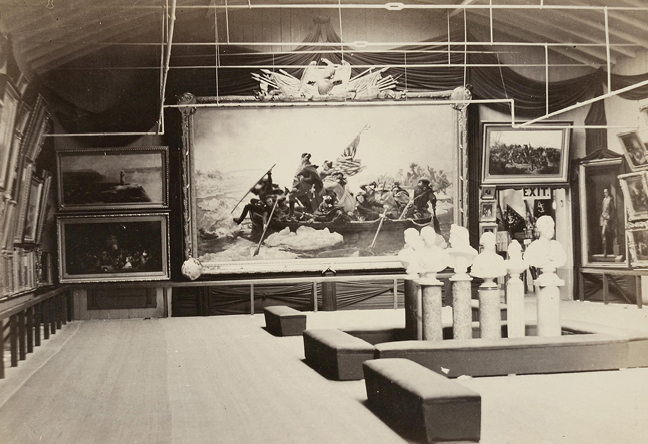
Photograph by Mathew Brady showing
Emanuel Leutze’s Washington Crossing the Delaware,
taken during an 1864 Art Exhibition
What have been the keys to your gallery’s longevity and its ability to stand the test of time?
There has been a need, from the late 20th century through today and for the foreseeable future, to replace the inappropriate frames in museums and private collections with the frames that the artists would have chosen in their time. An example of this need is the commissioned project by The Metropolitan Museum of Art to recreate a monumental frame for Emanuel Leutze’s Washington Crossing the Delaware, 1851, based on recently rediscovered documentary photographs by Mathew Brady. These rare images were taken during the 1864 Art Exhibition, when the painting was featured at the Metropolitan Fair in aid of the United States sanitary commission. The original frame in the Brady photographs had been inexplicably lost. This is the largest frame at The Metropolitan Museum, with the outer dimensions measuring approximately 14 x 23 feet. It also features a fully hand carved and gilded 14-foot wide crest, consisting of American Revolutionary War symbols including an eagle, flags, pikes, bayonets, a drum, and a munitions case, among many other details. An undulating ribbon at the base of the crest reads, “First in war, first in peace, first in the hearts of his countrymen,” a line excerpted from Henry Lee’s eulogy to Washington in 1799.
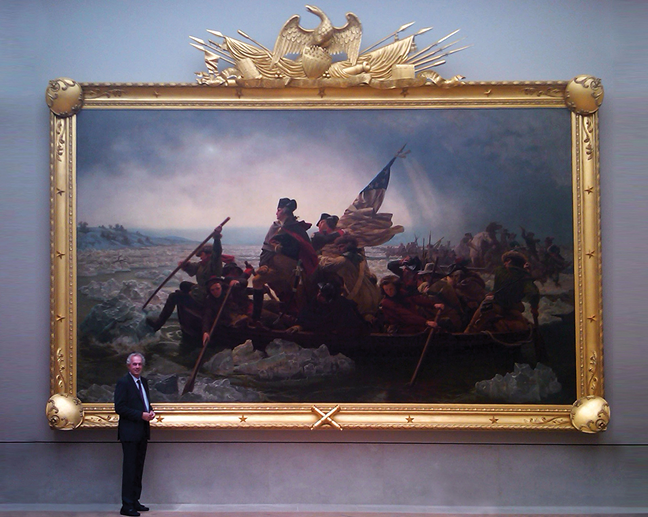
Eli Wilner with Emanuel Leutze’s Washington Crossing
the Delaware,
1851,
with a frame created by
Eli Wilner & Company,
The Metropolitan Museum of Art
My studio and gallery staff spent years doing in-depth research alongside The Met’s curators, meticulously handcrafting the frame to the smallest detail. The frame has a wide cove profile with acanthus-leaf and leaf-and-berry cast ornaments. In addition to the crest, hand-carved elements include the embellished shields at the corners and individual stars set inside the cove. Using over 12,500 sheets of gold, the entire frame surface was water-gilded in the traditional fashion. In preparation for this process, several layers of gesso were applied and sanded, followed by period-appropriate colors of clay, also commonly referred to as bole. After the gold leaf was delicately hand applied with squirrel hairbrushes, areas of the frame were selectively burnished with agate-tipped tools. Finally, the entire frame was finished and patinated to render the appearance of age with all its nuances and subtleties. The frame was so massive that it had to be designed for on-site assembly and was carried up the Museum’s Grand Stairwell in sections. The completed frame is now the centerpiece of the museum’s American Wing.
Another key to our success has been the extraordinary team that we put together of carvers, gilders, and finishers that is unmatched by any other framer working today.
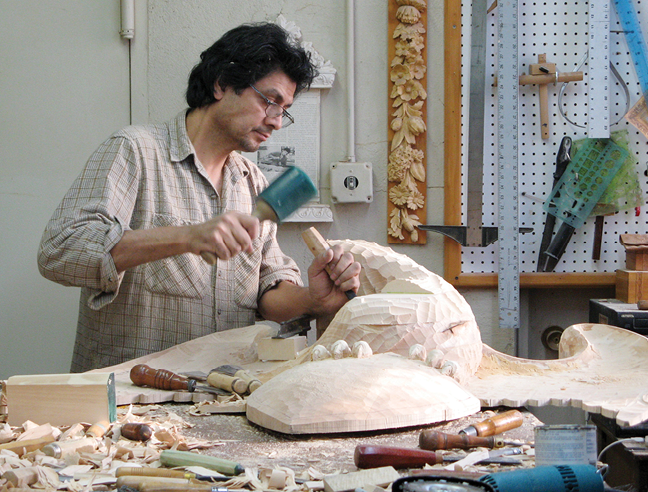
An artisan in the Eli Wilner studio carves the eagle crest for
Emanuel Leutze’s Washington Crossing the Delaware,
The Metropolitan Museum of Art
How did Eli Wilner adapt its business to address the challenges caused by the global pandemic?
Since clients were not coming to the gallery during the pandemic and the auction houses held more virtual sales, we reached out to museums and raised money with grants from collectors who appreciate the need that museums have for reframing and frame restoration.
Will you provide an overview of Eli Wilner’s service offerings?
We are currently focused on four divisions in our business model: Antique frames; Replication of antique frames; Antique frame restoration; and Replication of extraordinary furniture.
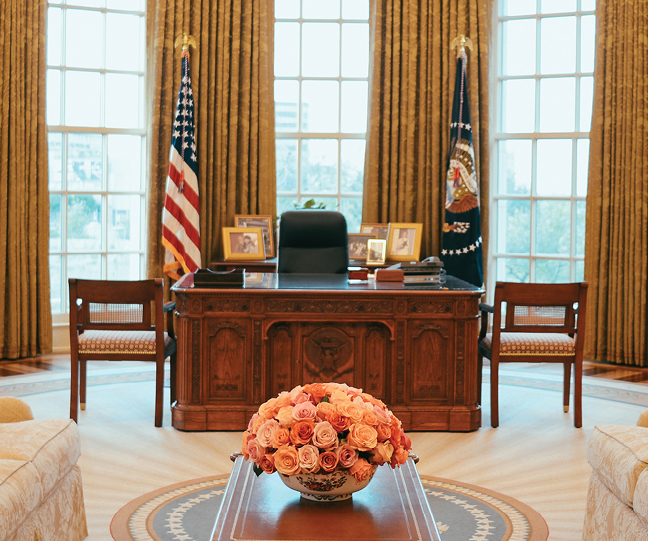
Eli Wilner Replica of the Resolute Desk, in the replica Oval Office
at the George W. Bush Presidential Library
Will you highlight Eli Wilner’s work in replicating the Resolute Desk?
We opened up a new division for the replication of extraordinary furniture. This division utilizes the carving and finishing skills we have been developing for years. One example of the work we have done is the recreation of the Resolute Desk, the elaborately carved oak desk used in the Oval Office, that was a gift from Queen Victoria to President Rutherford B. Hayes in 1880. We have sold four replicas of this desk during the pandemic. Our first Resolute Desk replica was completed in 2010 after a year of hand carving and finishing. That desk is now on display as part of the re-creation of the Oval Office in the George W. Bush Library in Texas.
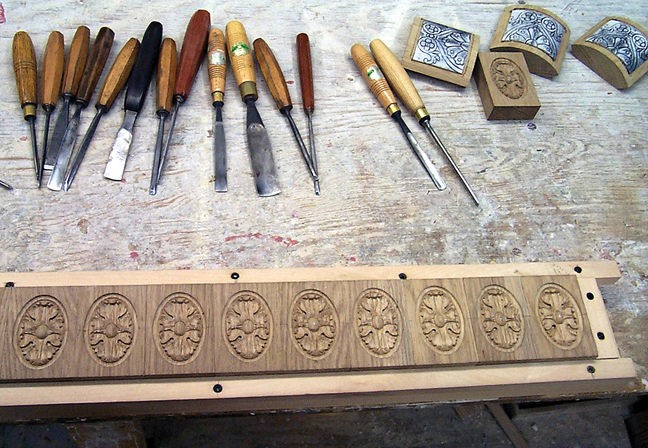
Foliate medallions for the replica Resolute Desk
being hand carved in the Eli Wilner Studio
How do you define the Eli Wilner client and how broad is your target market?
Our target market includes wealthy global private clientele such as legacy families and CEOs of major corporations, major international auction houses, and hundreds of not-for-profit cultural organizations across the country.
Another area that has been very active is the need by art insurance companies to repair their policyholders’ damaged frames. The finest insurance companies, such as AXA and Chubb, consider us to be their preferred provider for restoration services in these situations. If the frame is unable to be restored, it is usually required that it be replaced with a frame of equal or greater value. As examples, we recently had the following projects:
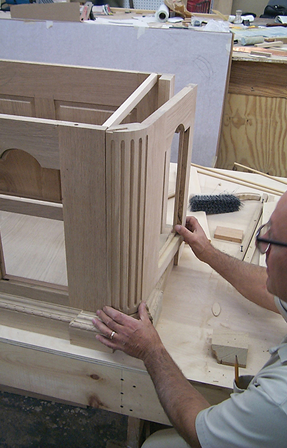
An artisan in the Eli Wilner studio assembles
a replica of the Resolute Desk
What are your key priorities for the business as you look to the future?
As COVID is finally relaxing its grip on the world, I plan to expand the business by purchasing a new building and increasing our staff members. We have also embarked on a very successful grant program for museums and other not-for-profit organizations. We have so far raised $240,000 and are about to raise another $240,000 in funds that have been earmarked to meet the framing needs of these organizations.![]()
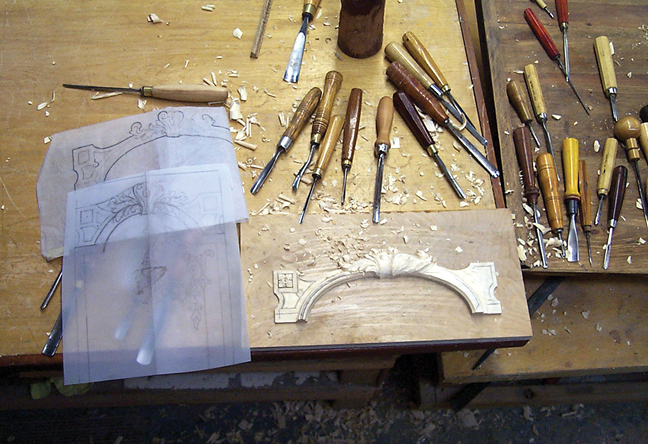
Hand carved ornament for a replica of the Resolute Desk